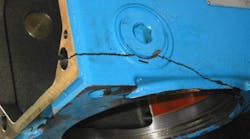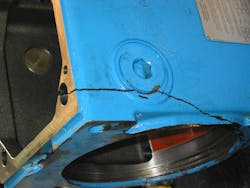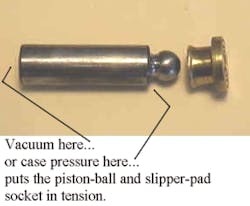A while back I posted this picture of a cracked, hydraulic piston-pump housing on my Facebook page.
One of my FaceBook Friends made the comment that for this to happen, the pump's rotating group would have to have failed and come apart in a spectacular way. Not so. And based on my long experience in the hydraulics repair biz, this being the cause of a cracked housing is a rare occurrence indeed.
But a cracked pump or motor housing due to a restricted (or blocked) case-drain line is far more common than you might think. Of course, if you forget to connect the drain line
in the first place, you effectively turn the pump or motor housing into a pressure vessel -- something it's not intended to be. Bang!
Similarly, if you connect a flowmeter into the pump or motor case drain line, to measure internal leakage, but forget to open the loading valve, this has the same effect: the housing fails spectacularly shortly after start-up. Don't laugh, I know of instances where this HAS happened.
But there's another all-to-common restriction to the drain line that can result in a cracked housing: filters. If there's a surge of leakage into the pump or motor case, and it can't escape due to the restriction of the filter, the resulting pressure spike CAN crack the housing. Or blow out its seal. But even if it doesn't have this dramatic effect, the presence of a filter in a piston pump or motor case-drain line often results in excessive case pressure. And high case pressure causes seal failure and mechanical damage.
Seal Failure
High case pressure results in excessive load on the lip of the shaft seal. This causes the seal lip to wear a groove in the shaft, which eventually results in leakage past the seal. And as already mentioned, if case pressure exceeds the shaft seal's design limits, complete failure can occur. And the subsequent loss of oil from the case of the pump or motor can result in damage through inadequate lubrication.
Mechanical Damage
The effect of high case pressure on axial piston pumps is the same as excessive vacuum at the pump inlet. Both conditions put the piston-ball and slipper-pad socket in tension during inlet (see below). This can cause buckling of the piston retaining plate and/or separation of the slipper from the piston, resulting in catastrophic failure.
In radial piston motors, high case pressure can cause the pistons to be lifted off their cam. This can occur in operation during the outlet cycle. The pistons are then hammered back onto the cam during inlet, destroying the motor. And if residual case pressure remains high when the motor is stopped, loss of contact between the pistons and cam can allow the motor to freewheel, resulting in uncontrolled machine movement.
For the reasons outlined above, depth filters are not recommended in case drain lines. While this does allow a small percentage of fluid to return to the reservoir unfiltered, in most applications the contamination risk is low and can be effectively managed using oil analysis and other condition-based maintenance practices.
Installing the wrong type of filter in the wrong location is one of my "6 Costly Hydraulics Mistakes...". For explanation of the other 5, download your copy of this free report here. It could save you a small fortune!



